The Price of Blue Zircon: Market Insights and Trends
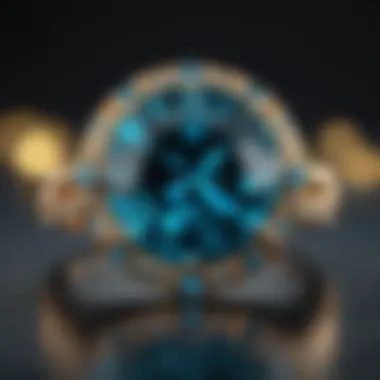

Intro
Blue zircon is a gemstone that has recently gained recognition for its unique colors and remarkable properties. This article aims to provide a comprehensive understanding of blue zircon's value, market trends, and its intricate role in jewelry. It is important to consider various aspects that contribute to its pricing. These include geological properties, market factors, historical significance, and comparisons with other gemstones.
Gemstone Overview
Definition and Origins
Blue zircon is a natural gemstone that comes from the mineral zirconium silicate. It forms under high temperature and pressure conditions in the earth's crust. This gemstone is known for its striking blue hues, which range from light sky blue to deep ocean blue. The origins of blue zircon can be traced back to various locations worldwide. Notable sources include Cambodia, Myanmar, and Sri Lanka. Each source produces shades with unique characteristics.
Historical Significance
Throughout history, zircon has been revered in multiple cultures. In ancient times, it was believed to have protective properties. It was often used in talismans and jewelry, believed to bring good fortune to its wearer. Blue zircon specifically emerged in jewelry during the 18th century, gaining popularity among collectors and enthusiasts. Understanding this historical backdrop enhances appreciation for its current market presence and value.
Gemstone Properties
Hardness and Durability
One of the most significant aspects of blue zircon is its hardness. On the Mohs scale, blue zircon ranks between 6 and 7.5, making it relatively durable compared to other gemstones. Its toughness means it can withstand daily wear, making it suitable for various types of jewelry, including rings and pendants. However, it is essential to handle it carefully, as it can still be vulnerable to scratches and other damages.
Color and Clarity
The color of blue zircon is its most distinguishing feature. This gemstone is available in a range of shades, influenced by the presence of trace elements during its formation. Pure blue zircon tends to exhibit high clarity. However, many stones may contain inclusions, which can affect their value. Generally, stones with richer colors and fewer inclusions are more sought after in the market.
"The value of blue zircon is significantly affected by its color and clarity, making these attributes critical when evaluating its worth."
Finale
By understanding the properties and significance of blue zircon, buyers and collectors can navigate its market more effectively. This knowledge allows for informed purchasing decisions, ensuring appreciation of the gemstone's beauty and value.
Preface to Blue Zircon
Blue zircon is a gemstone with a fascinating story and distinct characteristics that merit attention. By understanding its essence, enthusiasts and potential buyers can navigate its market more effectivly. The following sections will delve into the fundamentals of blue zircon, examining what it is, its historical significance, and various aspects that highlight its value.
What is Blue Zircon?
Blue zircon is a natural gemstone known for its captivating blue hues that range from pale azure to deep cobalt. Unlike cubic zirconia, which is synthetic, blue zircon is mined from the earth and has unique properties that distinguish it. It is a mineral that belongs to the zircon family, primarily made up of zirconium silicate. Its brilliant luster, high refractive index, and excellent brilliance make it a popular choice in jewelry.
Zircon's vibrant blue color arises from various factors, including trace elements, which result in unique color variations. These variations can influence the market price. Typically, the gem is faceted in a way that enhances its natural sparkle and allure.
Overall, blue zircon is cherished for both its beauty and its rarity, making it an appealing option for collectors and jewelry designers alike.
Historical Significance
Historically, blue zircon has been valued not just for its aesthetic appeal but also for its cultural connotations and applications. In ancient times, it was often mistaken for other gemstones. There are mentions of zircon in historical texts dating back to the Middle Ages. It was prized by many civilizations as a symbol of wealth and power. Ancient Egyptians used zircon in various ornaments, believing it to promote love and wisdom.
During the 19th century, zircon gained popularity in Europe as an alternative to diamonds, due to its remarkable brilliance. In more recent times, advancements in gem-cutting techniques have allowed for the emergence of more intricate designs, further enhancing its desirability.
Understanding the historical context of blue zircon can provide insights into current market trends, as the past often influences present valuation. Its legacy continues today, where it stands as a desirable gem in modern jewelry making.
The Geological Background
Understanding the geological background of blue zircon is essential for grasping its market position and value. This section provides detailed insights into the formation and sourcing of blue zircon, emphasizing the unique elements that influence its supply and quality. The geological properties significantly affect the pricing, as they determine the desirability and unique characteristics of the stones available in the market.
Formation Process
Blue zircon is formed under high-pressure and high-temperature conditions deep within the Earth's crust. This metamorphic process often takes millions of years, contributing to its rarity. The main component of zircon is zirconium silicate, which undergoes various geological processes that influence its color and clarity.
The color variations are a direct result of different trace elements integrated during its formation. For example, titanium can deepen the blue hue, while the presence of iron may alter saturation. The complex interplay of these factors makes the formation process crucial in determining the gemstone's final appearance.
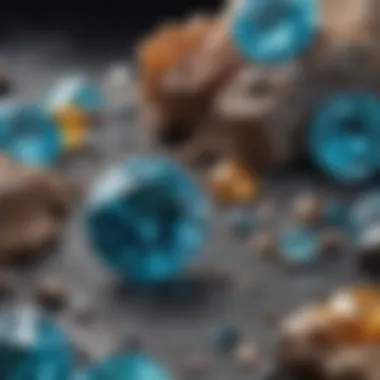
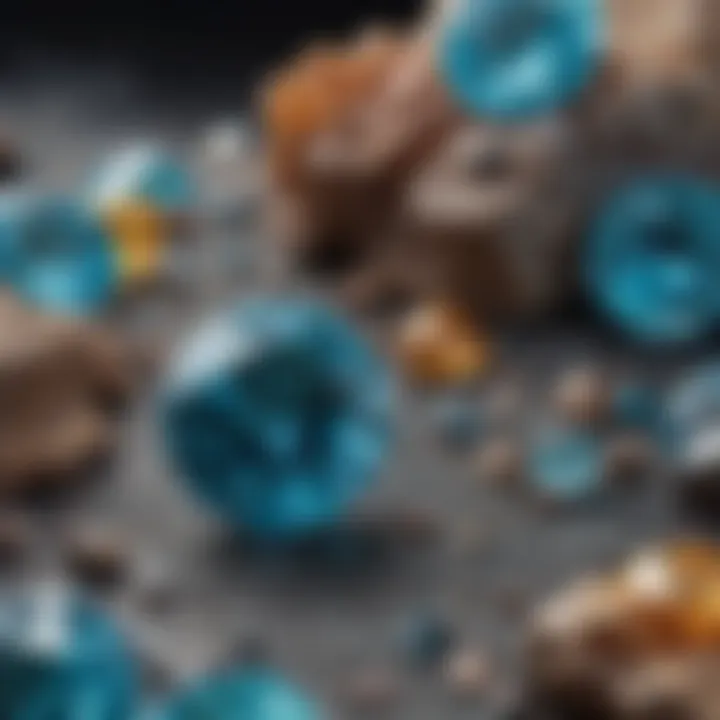
Zircon can also undergo a process called metamictization, whereby radiation causes structural changes. Though it may weaken the stone over time, it can create unique characteristics that some collectors may find appealing. The understanding of this formation process aids in evaluating and authenticating blue zircon in the market.
Global Sources
The production of blue zircon is not limited to one location but spans several regions across the globe. Each source has unique characteristics that impact the stone's quality and market value.
Cambodia
Cambodia is known for producing some of the world's finest blue zircon. The stones from this region are renowned for their vibrancy and clarity. One key characteristic of Cambodian blue zircon is its often deep, saturated color. This makes them particularly popular in high-end jewelry. One unique feature is the minimal inclusions found in many of the stones, ensuring a brilliant appearance that appeals to collectors and designers alike. However, a challenge for Cambodian zircon is the increasing competition from other regions, which may impact their pricing and availability.
Sri Lanka
Sri Lanka has a long-standing reputation in gemstone production, and blue zircon is no exception. The gemstones from this island nation are famous for their distinct quality and historical significance. Sri Lankan blue zircons often showcase subtle hues and excellent transparency. The unique geological formations found in Sri Lanka allow for a diverse range of blue zircon, catering to various aesthetic preferences. However, challenges exist, such as fluctuating political conditions that can affect mining and export activities.
Tanzania
Tanzania stands out as one of the emerging sources for blue zircon. The region has gained attention due to the discovery of large deposits, making it an increasingly popular source for this gemstone. Tanzanian blue zircon tends to display a lighter blue color, which can appeal to buyers looking for something different from the deeper hues commonly seen elsewhere. One advantage of Tanzanian zircon is the relatively lower cost compared to stones from more established sources. However, quality can vary significantly, leading to potential risks for buyers unsure about the grading of their purchases.
Quality Factors Affecting Blue Zircon Pricing
Understanding the quality factors that influence blue zircon pricing is essential for both consumers and professionals in the jewelry industry. Several elements play vital role in determining the value of blue zircon, and knowing these can aid buyers in making informed decisions. Quality factors are not just about aesthetics; they also encompass individual characteristics that can influence market demand. Therefore, it is important to analyze these aspects carefully.
Color Variations
Color is one of the most significant factors affecting the price of blue zircon. This gemstone is primarily known for its striking blue hues, which can range from a light sky blue to a deep, intense blue. The specific shade, saturation, and overall uniformity of color can markedly influence pricing.
Generally, the most desirable blue zircon has a vivid and pure blue color that mimics the richness of sapphires. For instance, lighter shades might fetch lower prices due to reduced demand. Conversely, darker, deeper blues that are also clear may see higher valuations.
Factors influencing color variations include:
- Heat treatment: Some blue zircon is treated to enhance its color. Treated stones might sell at lower prices compared to their untreated counterparts.
- Natural color: Natural blue options are rarer and often command a higher premium.
Clarity and Cut
Clarity is another critical consideration. This refers to the presence or absence of inclusions and blemishes within the gemstone. A blue zircon with high clarity is generally more sought after and tends to be valued higher. It is vital for potential buyers to examine the stone closely for any visible flaws.
The cut of the blue zircon significantly impacts its brilliance and overall appearance. An expertly cut stone maximizes light reflection and enhances visual appeal. Proper cutting can bring forth the gem's natural colors and clarity better than an inferior cut.
Key points about clarity and cut include:
- Types of cuts: Common styles include oval, round, or cushion cuts. Each has unique characteristics that affect how the stone captures and reflects light.
- Position of inclusions: If inclusions are located in less visible areas, they may not substantially affect the stone’s value.
Size Considerations
The size of blue zircon is another factor that plays a role in its pricing. Larger stones naturally tend to cost more, mainly due to their rarity. However, the relationship between size and price is not linear.
Several considerations come into play regarding size:
- Carat weight: As the carat weight increases, prices tend to escalate. Larger stones are more prized, but the increase might not be proportional.
- Visual size: Sometimes, a smaller stone can appear larger due to its cut and clarity. This visual perception can influence its marketability.
Market Trends Overview
Understanding market trends is crucial for anyone interested in blue zircon. Trends reflect not only the current pricing but also the potential future direction of the market. Knowledge of these factors aids collectors, investors, and enthusiasts in making informed decisions. Additionally, an overview of market trends highlights shifts in buyer preferences, which can influence the desirability and pricing of blue zircon.
Recent years have shown an increase in the appreciation for unique and less common gemstones like blue zircon. As consumers shift from traditional choices to more distinct selections, the awareness surrounding blue zircon is growing. This change has significant implications for its market behavior and price stability.
The factors influencing these trends include global demand, availability of quality stones, and macroeconomic conditions. Keeping an eye on these will provide insights into the future prospects of blue zircon as a compelling investment or jewelry choice.
Current Pricing Trends
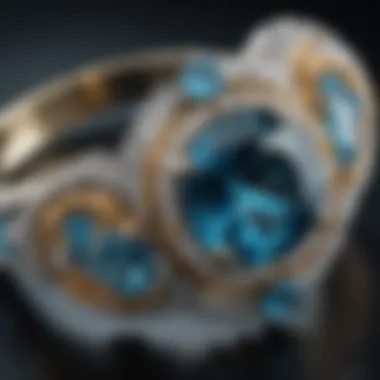
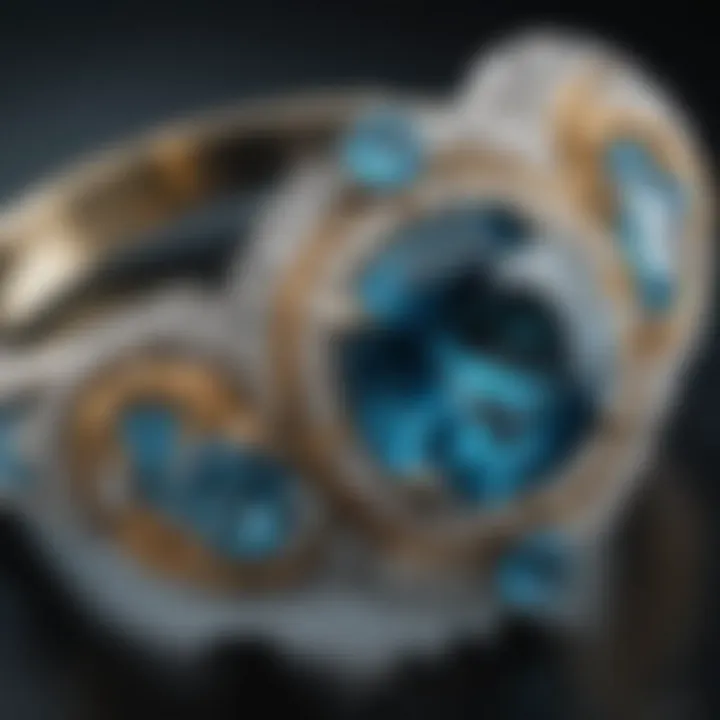
Currently, the price of blue zircon is influenced by multiple factors, including color quality and availability in the market. Blue zircon tends to fetch higher prices when it exhibits a vivid blue hue, which is often associated with higher demand. With a growing appreciation for colored gemstones, particularly among younger generations, the market continues to see fluctuations. Recently, the average price for high-quality blue zircon has increased steadily, suggesting a favorable trend for sellers.
Comparative Analysis with Other Gemstones
Topaz
When comparing blue zircon with topaz, one key aspect is pricing stability. Topaz is known for its wide range of colors and affordability, making it a popular choice. It is often utilized in various types of jewelry. The key characteristic of topaz is its range; it can appear in shades of blue, yellow, and pink. For many buyers, topaz represents a beneficial or popular option due to lower costs compared to blue zircon. However, blue zircon’s brilliance and unique properties set it apart, making it more desirable for collectors.
Aquamarine
Aquamarine offers a beautiful blue hue, similar to blue zircon, which attracts a distinct audience. The main appeal of aquamarine is its serene color and the fact that it is often larger and lighter than blue zircon. This gemstone serves as a strong competitor in the blue gemstone market. However, aquamarine can be less brilliant when compared to blue zircon. While aquamarine is widely available, the unique fire and brilliance of blue zircon often grant it a pricing edge among gemstone enthusiasts.
Sapphire
Sapphire is another well-known gemstone that frequently enters discussions around blue zircon. The key characteristic of sapphire is its rich saturation and durability, making it a classic gemstone choice. Its desirability comes from both cultural significance and the fact that high-quality sapphires can command very high prices. In this sense, blue zircon is often seen as a unique substitute. The unique feature of blue zircon—its exceptional clarity and sparkle—gives it an advantage for those looking for something distinctive. While sapphires have longevity in the market, blue zircon’s market position is favorable for those interested in novel options and unique pieces.
Factors Influencing Market Prices
Understanding the factors that influence market prices of blue zircon is crucial for both buyers and collectors. These elements help in assessing the value and future potential of this gemstone. By grasping these influences, one can navigate the complex market more effectively. Factors like economic indicators and demand and supply dynamics are especially significant. They help paint a clearer picture of the pricing landscape and its fluctuations over time.
Economic Indicators
Economic indicators serve as key benchmarks in determining the overall health of the market. When the economy grows, consumer confidence typically rises. This can lead to an increase in demand for gemstones, including blue zircon. Conversely, during economic downturns, luxury spending may decline.
Factors such as inflation rates and employment levels also play roles in this context. For example, high inflation can erode purchasing power, affecting the luxury market, and ultimately the pricing of blue zircon.
In addition, shifts in currency values impact international trade. A strong currency can make imported stones more expensive, while a weaker currency may inflate prices for domestic buyers. Observing these indicators can guide potential buyers on when to enter the market.
Demand and Supply Dynamics
The balance between demand and supply is fundamental in understanding the price movements of blue zircon. When demand exceeds supply, prices typically rise. Currently, the growing popularity of blue zircon in the jewelry market is driving demand. Coming from regions like Cambodia or Sri Lanka, the extraction rates may not keep pace with the rising interest.
Moreover, the quality of blue zircon plays a significant role in its market positioning. High-quality stones can fetch much higher prices compared to lower-grade options. Consequently, if many low-grade stones are available, prices may stagnate or decrease.
Factors such as technological advancements in gem cutting can also influence market dynamics. Improved techniques can enhance the visual aesthetics and value of blue zircon.
In summary, by analyzing economic indicators and understanding demand and supply dynamics, investors and buyers can make more informed decisions about purchasing blue zircon, ensuring they capitalize on market trends effectively.
Buying Blue Zircon: What to Consider
Purchasing blue zircon can be a significant decision for both collectors and enthusiasts. Understanding the factors that influence the value of blue zircon is crucial. Buyers must evaluate both the quality and authenticity of the stone. Proper knowledge helps in making an informed choice, as investing in gemstones can be intricate.
Certification and Authentications
Certification and authentication are essential steps when buying blue zircon. Certificates from reputable gemological laboratories should accompany the gemstones. These documents confirm the stone's quality and characteristics. They also help in determining if the zircon is natural or treated. Buyers should seek certificates from entities such as the Gemological Institute of America or the American Gem Society.
Without proper certification, there is a higher risk of purchasing a simulated or fake stone. It is advisable to ask for a certificate before proceeding with any transaction. In essence, certification acts as a safeguard ensuring the buyer's investment is genuine and valued accurately.
Where to Buy
Deciding where to buy blue zircon involves assessing various options. Each avenue offers distinct benefits and drawbacks.
Online Retailers
Online retailers provide convenience and a wide selection of blue zircon. This platform allows buyers to compare prices easily. Renowned websites like Blue Nile or James Allen are popular choices where gemstone shoppers often go. One key characteristic of online retailers is the availability of customer reviews. These reviews can give insights into the quality of stones and reliability of the seller.
However, purchasing online also carries risks. The primary risk involves not being able to physically inspect the stone before buying. This aspect can lead to potential disappointment if the product does not match expectations. Thus, buyers should look for retailers offering a return policy.
Local Jewelers


Local jewelers have their own unique advantages. Shopping in these stores allows buyers to examine blue zircon closely. Seeing the sparkle and color in person helps in making an informed choice. Local jewelers often provide personalized service. This can enrich the buying experience significantly.
The downside may include a smaller selection compared to online retailers. Additionally, the prices may be higher as local jewelers cover overhead costs. However, for those perplexed by making choices, the expert advice from local jewelers can often be beneficial.
Auction Houses
Auction houses offer a different approach to acquiring blue zircon. They can provide access to rare or exceptionally high-quality stones that may not be available elsewhere. Participating in auctions can be exciting. It allows buyers to potentially secure a blue zircon at a competitive price.
However, the process requires some level of expertise. Buyers must understand the auction process well. Additionally, some auction houses may charge premium fees which could increase the final cost. Therefore, researching prior auction results can help buyers gauge fair pricing.
Caring for Blue Zircon
Caring for blue zircon is crucial for maintaining its allure and value over time. As a gemstone, blue zircon requires specific attention to ensure it remains vibrant and free from damage. Knowledge about proper care steps is essential for gemstone enthusiasts, collectors, and jewelry designers. A thorough understanding of cleaning, maintenance, and storage best practices can significantly extend the life and beauty of this remarkable stone.
Cleaning and Maintenance
When it comes to cleaning blue zircon, gentle methods are preferred. Here are some key practices to follow:
- Use Mild Soap and Water: A mixture of lukewarm water and mild soap is often sufficient. Avoid harsh chemicals, as they can damage the stone’s surface.
- Avoid Ultrasonic Cleaners: Blue zircon has inherent brittleness. Ultrasonic cleaning can cause cracks or chips.
- Soft Cloth for Drying: After washing, use a soft, lint-free cloth to dry the gemstone. Avoid abrasive materials that may scratch its surface.
- Regular Maintenance: Keep blue zircon settings and clasps clean. Inspect for loosening or damage regularly to maintain both gemstone security and aesthetics.
Adopting these habits can help preserve the brilliance and clarity of blue zircon for years to come.
Storage Recommendations
Proper storage is another vital aspect of caring for blue zircon. Consider these practices for optimal preservation:
- Individual Storage: Store blue zircon pieces separately to avoid contact with other gemstones that may scratch or damage it.
- Use Soft Pouches or Boxes: Place each item in a soft pouch or a dedicated jewelry box. This provides a cushioning effect, protecting against impacts.
- Controlled Environment: Keep blue zircon in a cool, dry place, away from direct sunlight. Extreme temperatures or humidity can adversely affect the stone.
- Avoid Physical Pressure: Do not stack heavy items on top of zircon to prevent pressure that could lead to breakage.
"Care and proper handling of blue zircon are as important as understanding its market value." This acknowledgment of care extends the stone's lifespan, contributing to sustained aesthetic appeal and investment potential.
The Future of Blue Zircon Pricing
The future pricing of blue zircon is a critical element of understanding its market dynamics. As trends shift in the gemstone industry, various factors contribute to changes in value. The characteristics of blue zircon and its perception in the jewelry market can have long-lasting effects on its pricing. Knowing these future market shifts and investment considerations is essential for collectors, enthusiasts, and potential buyers.
Potential Market Shifts
The blue zircon market may encounter several potential shifts in the coming years. These shifts can arise from consumer trends, mining activity, and the overall economic landscape.
- Consumer Preferences: More consumers are seeking unique and ethically sourced gemstones. This may enhance the appeal of blue zircon, elevating its status amid other gemstones.
- Sustainable Jewelry Movement: A growing emphasis on sustainability could drive demand for blue zircon. This gemstone has a distinct geological formation that differentiates it from more common options. As people become more conscious about the origins of their jewelry, blue zircon could attract increased attention.
- Technological Advances: Technological improvements in gemstone processing and marketing may also impact blue zircon’s availability. If advancements allow for better quality assessments or new methods of sourcing, the market could respond positively.
- Global Economic Conditions: Economic fluctuations can significantly impact luxury goods markets, including gemstones. A resurgence in economic confidence could see an uptick in jewelry buying, positively affecting blue zircon pricing.
"Understanding market shifts is indispensable for anyone looking to invest in blue zircon or enhance their collection."
Investment Considerations
When contemplating an investment in blue zircon, several considerations must be taken into account. The following points can help guide potential buyers in their decision-making processes:
- Rarity and Quality: High-quality blue zircon is relatively rare compared to other gemstones. Its unique prices can appreciate over time, making it a solid investment.
- Appraisal and Certification: Prioritize obtaining certified pieces and professional appraisals. This ensures the authenticity and quality of the gemstone, which is crucial for any investment.
- Market Research: Keep abreast of current market trends and historical pricing data. Awareness of price fluctuations will support more informed decisions when buying or selling.
- Long-Term Perspective: Investing in gemstones like blue zircon often requires a long-term view. Market volatility can affect short-term prices, but the potential for appreciation may be more attainable over a longer period.
Culmination
The value of blue zircon is not just tied to its aesthetic appeal but is deeply connected to the dynamics of the market, consumer trends, and various economic factors. In this article, we have explored multiple aspects that define blue zircon pricing, illuminating why potential buyers and enthusiasts must grasp these intricacies.
Summarizing Key Insights
Several key points emerge from this exploration of blue zircon pricing.
- Quality Factors: Elements like color, clarity, and cut significantly influence the value of blue zircon. Not all stones are equal, and understanding these factors helps buyers assess what they are purchasing.
- Market Trends: Current demands and supply levels are important. As interest in gemstones shifts, so does pricing, impacted by global economic conditions.
- Investment Potential: Blue zircon represents not only an ornamental stone but also an investment. Recognizing its potential to appreciate over time can inform purchase decisions.
Being armed with this knowledge positions buyers advantageously in a complex and evolving market.
Final Thoughts on Blue Zircon
In summary, blue zircon offers both beauty and value, making it a popular choice among collectors and jewelry makers. Its captivating blue hue and unique characteristics demand attention not only for their visual appeal but also for their finance-related opportunities.
As this market continues to evolve, staying updated on trends, pricing, and market conditions is crucial for anyone looking to invest or acquire blue zircon.
Blue zircon is more than just a gemstone; it carries the potential for appreciation and enjoyment. Making informed decisions regarding purchases will undoubtedly serve both collectors and casual buyers well in their endeavors to appreciate and cherish this remarkable stone.



